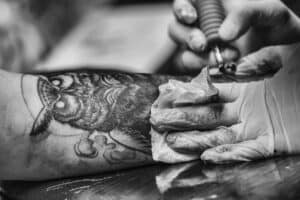Race as the Epitome of an Individual’s Identity
Considering the classic definition of racism,1 the logical first step in eradicating racial discrimination is to reaffirm the inherent value of all people, while simultaneously distancing ourselves from superficial differentiations—such as race. Advocating such departure from collective identity in his famous 1963 speech, Martin Luther King Jr. passionately proclaims., “I have a dream that my four little children will one day live in a nation where they will not be judged by the color of their skin but by the content of their character. . . . [that one day] little black boys and black girls will be able to join hands with little white boys and white girls as sisters and brothers.”2
Breaking the mold of divisive racial identification, we can seek individual distinctiveness through our meritorious accomplishment and defining character, while simultaneously embracing features of group identity which promote cohesion among subpopulations. For example, multiracial people identifying as Americans remain united by underscoring ideological beliefs (i.e., the underpinnings of our constitutional republic), while Christians find unity in the profession of essential Christian doctrines.3 Embracing such collective identities ultimately promotes a system of unified diversity, recognizing the unique contributions of individual members, while emphasizing the crucial importance of multicultural and multigenerational companionship, devoid of any socioeconomic (or other frivolous) division.4 Moreover, relationships arising from common worldview perspectives or shared ideological beliefs, ultimately prove more consequential than those organized around peripheral commonalities or inconsequential physical attributes.5
Progressing in the opposite direction, DiAngelo’s worldview highlights race as the foundational aspect of human identity, thereby nullifying any semblance of individualism, while requiring every facet of human existence to be interpreted through the lens of race.6 Unsurprisingly, DiAngelo specializes in whiteness studies, a field that presupposes the existence of “invisible structures that produce and reproduce white supremacy and privilege,” and places race at the center of sociological analysis.7 Explicitly revealing the single-mindedness of her worldview, DiAngelo writes, “I am a white American. . . I have a white frame of reference and a white worldview, and I move through the world with a white experience. . . . I was socialized as white in a racism-based society, I have a racist worldview, deep racial bias, racist patterns, and investments in the racist system that has elevated me.”8 Unfortunately, deciphering every facet of life through the collectivist lens of race will ultimately result in false attributions of casual relationships (as revealed in DiAngelo’s redefinition of racial terminology), while removing any basis for individual accomplishment or failure.
For example, people in the racial majority cannot be credited with achievement, as their success solely emerges because of racial factors. Similarly, since race serves as the sole determinant of a person’s character and circumstances, failure cannot be ascribed to anyone in the racial minority, as physical phenotypes predetermine the outcome. Thus, DiAngelo perceives white-supremacy as the foundation of western culture, producing a society that remains divided into a racial hierarchy, in which whites maintain oppressive social and institutional power over their “colored” counterparts—a perspective DiAngelo demands her audience to accept.9
The Suppression of Logic
Seemingly discounting the intellectual capabilities of her audience, DiAngelo expects her readers to acknowledge her redefinition of racial terms without scrutiny, while blindly conceding that all white people are racist and western societies are part of an inherent white-supremacist civilization. Managing the expectations of her audience, DiAngelo outright refuses to justify her flabbergasting assertions, writing, “This book does not attempt to provide the solution to racism. Nor does it attempt to prove that racism exists; I start from that premise.”10 Just to be clear, DiAngelo unambiguously implicates her target audience in racism,11 while refusing to justify the charge in any meaningful or intelligible way,12 and simultaneously declining to offer any possible solutions to the problem. Accordingly, it is best to recognize this book as a polemic against western institutions—or perhaps a racist diatribe—rather than a logical analysis of sociological or racial issues, or a resource for enhancing cross-cultural interactions. Consequently, DiAngelo finishes the book without offering any semblance of hope, concluding, “Even if challenging all the racism and superiority we have internalized was quick and easy to do, our racism would be reinforced all over again just by virtue of living in the culture.”13
Surprisingly, when DiAngelo conducts seminars, participants inevitably take offense to DiAngelo’s assertions (DiAngelo recounts numerous examples of this throughout the book) demanding justification for her claims, while fundamentally rejecting any affiliation with white supremacy. Rather than critically examining her worldview, leveraging relevant empirical data, or presenting sound philosophical argumentation to support her position, DiAngelo diagnoses any opposition with white fragility—a condition manifesting in emotions of anger, fear, or guilt, and behaviors of argumentation, silence, or withdrawal. White fragility finds foundation upon a sociology of dominance—the socialization of white people “into white supremacy, which exercises means to protect, maintain, and reproduce white supremacy,” and such responses “work to reinstate white equilibrium” by repelling challenges, thereby assisting the person in returning to a place of “racial comfort,” while maintaining their “dominance within the racial hierarchy.”14 Essentially, DiAngelo’s audience is forced into the awkward position of either self-identifying as a racist or receiving the label of a racist with white fragility.
Considering these factors holistically, the extent of DiAngelo’s intellectual dishonesty becomes readily apparent. Maintaining an unchallenged racist worldview, DiAngelo reimagines racial terminology to fit her schema, practices equivocation to form misleading statements, assumes her central premise without providing support, and maliciously seeks to render her assertions unfalsifiable.15 Therefore, the thoughtful reader will quickly recognize her intellectual dishonesty, poor scholarship, racist worldview, thus requiring the emphatic rejection of DiAngelo’s contentions. Moreover, these dynamics render the publication detrimental to cross-cultural relationships and ought to solidify White Fragility as an offensive and contemptuous publication, regardless of the reader’s race.16
- See “Fragile Logic: Examining White Fragility (Part 1).”
- Martin L. King Jr., “I Have a Dream,” Speech presented at the March on Washington for Jobs and Freedom, Washington, D.C., August 28, 1963, https://kinginstitute.stanford.edu/king-papers/documents/i-have-dream-address-delivered-march-washington-jobs-and-freedom.
- For additional details on the basic Christian worldview, see “Worldview in Question: Outlining the Christian Worldview.”
- For further exploration of this topics, see “The Importance of Community: An Exegetical Examination of Ephesians 4:7-16.”
- Steve Duck, Meaningful Relationships: Talking, Sense, and Relating (Thousand Oaks, CA: Sage Publications Inc., 1994).
- Throughout White Fragility, DiAngelo explicitly or implicitly identifies race as the sole determinant of our character, since shaping our perspectives, experiences, and responses. Cf. Robin DiAngelo, White Fragility (Boston, MA: Beacon Press, 2018), 5; 11; 40-42; 51-70; 80; 85; 149; .
- Barbara Applebaum, “Critical Whiteness Studies,” Oxford Research Encyclopedias, June 2016, https://oxfordre.com/education/view/10.1093/acrefore/9780190264093.001.0001/acrefore-9780190264093-e-5; Robin DiAngelo, “About Me,” RobinDiangelo.com, Accessed July 18, 2020, https://robindiangelo.com/about-me/.
- DiAngelo, White Fragility, 1; 149.
- Robin DiAngelo, “Services,” RobinDiangelo.com, Accessed July 18, 2020, https://robindiangelo.com/services/; DiAngelo, White Fragility, 1; 95; 149; 152-153.
- Ibid., 5.
- DiAngelo identifies her target audience as “white.” See DiAngelo, White Fragility, xiv.
- Any attempt DiAngelo makes to substantiate her assertions through the publication, completely relies on qualitative distillations of anecdotal observations, rather than empirical data, contemporary peer-reviewed research studies, philosophical arguments, or scholarly analysis.
- DiAngelo, White Fragility, 154.
- Ibid., 2; 112-113.
- For those interested in additional logical fallacies DiAngelo exhibits throughout the publication, the list includes, but is not limited to: alleged certainty, cum hoc ergo propter hoc, begging the question, equivocation, reification, appeal to equality, willed ignorance, ecological inference fallacy, ad hominem (circumstantial and guilt by association), alternative advance, vacuous argument, appeal to authority, appeal to common belief, cherry picking, fallacy of composition, conspiracy theory, special pleading, biased sample fallacy, casual reductionism, argument from incredulity, and fallacy of opposition.
- For a thoughtful discussion of DiAngelo’s patronization of racial minorities, see John McWhorter, “The Dehumanizing Condescension of White Fragility,” The Atlantic, July 15, 2020, https://www.theatlantic.com/ideas/archive/2020/07/dehumanizing-condescension-white-fragility/614146/.




